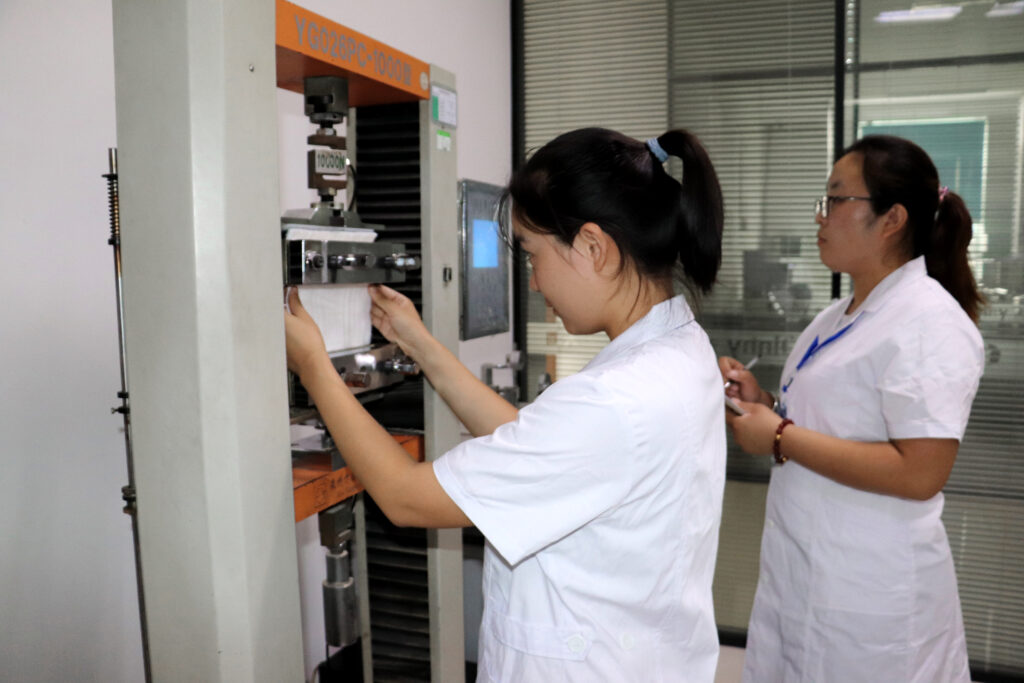Puncture strength test of geomembrane
The puncture strength test of a geomembrane is a key test to evaluate its performance against puncture forces. This test helps determine the puncture resistance of the geomembrane when faced with puncture forces, which is critical to the reliability of the geomembrane in projects such as anti-seepage and slope protection. The following are the steps generally used for puncture strength testing of geomembranes:
Specimen Preparation: Cut specimens from the geomembrane that meet specifications, usually square or round, to ensure representativeness of the test. Preparation of the specimen requires care to ensure that the edges of the specimen are flat to avoid additional effects.
Test equipment: Use a special puncture testing machine for testing. The fixture of the puncture testing machine should be adapted to the size and shape of the geomembrane specimen and be able to apply puncture force.
Sample clamping: Clamp the geomembrane sample in the clamp of the puncture testing machine, ensuring that the design of the clamp does not cause local concentrated stress on the sample, but is applied evenly on the sample.
Apply load: Gradually apply puncture force until puncture occurs in the specimen. The applied force and the puncture deformation of the specimen were recorded during the test.
Data recording and analysis: Record the data during the test, including the maximum puncture force and the puncture deformation of the specimen. Puncture strength is usually expressed in terms of force per unit area, and common units are N/m² or kN/m².
Calculation results: Calculate the average value of the puncture strength and possibly perform other analyses, such as the surface morphology of the specimen after puncture.
The standards for these tests usually involve specific test parameters, equipment specifications and data recording methods, usually provided by relevant international standards, industry specifications or manufacturers. Puncture strength testing helps evaluate the performance of geomembranes when facing puncture forces and provides important design and selection basis for engineering applications.
Penetration strength test of geomembrane
The penetration strength test of a geomembrane is to evaluate its barrier properties against moisture or other liquids. This test is usually used to confirm the reliability of geomembranes in anti-seepage projects. The following are the steps generally used for geomembrane penetration strength testing:
Specimen Preparation: Cut specimens from the geomembrane to specifications, usually square or rectangular, to ensure representativeness of the test. The preparation of the specimen requires attention to ensure the sealing of the edges to simulate the use conditions in actual engineering.
Test Equipment: Use specialized permeability testing equipment, such as permeability instruments or permeability testing devices. These devices typically include liquid supply systems, specimen supports, and liquid collection systems.
Specimen Installation: Install the geomembrane specimen in the testing equipment, ensuring that the specimen is not damaged and is properly clamped. The edges need to be tightly sealed to ensure that the liquid being measured does not penetrate through the edges.
Liquid supply: Use a specified liquid, usually water or other specific liquid, to apply a certain pressure through the specimen. Relevant data need to be recorded as the liquid flows through the sample.
Data recording and analysis: Record the time of liquid flowing through the sample, liquid pressure and other data. These data are used to calculate the permeability performance of the geomembrane.
Calculation results: Calculate the penetration strength, usually expressed in terms of liquid flux per unit area. Common units are L/m²·s or mm/s.
The specific procedures and criteria for these tests may vary for different applications and specifications. Usually, relevant international standards, industry specifications or manufacturers provide detailed test procedures and requirements. Proper testing can help evaluate the anti-seepage performance of geomembranes and ensure that they meet design requirements in actual applications.

Chemical stability testing of geomembranes
Chemical stability testing of geomembranes is designed to evaluate their durability and stability in different chemical environments. This is important because geomembranes are often used in environments where they are exposed to a variety of chemicals, such as chemicals in soil, dissolved substances in bodies of water, or chemicals in industrial settings. The following are the steps generally used for chemical stability testing of geomembranes:
Specimen Preparation: Cut specimens from the geomembrane to specifications, usually square or rectangular. Preparation of the specimen requires care to ensure that its dimensions are consistent with the test requirements, and multiple specimens using different chemistries may need to be considered.
Test Liquid Preparation: Prepare liquids that simulate chemicals that may be encountered in actual applications. This may include acids, bases, organic matter, etc. The concentration and temperature of the liquid should generally match the actual application environment.
Sample soaking: Soak the sample in the simulated liquid for a certain period of time. Testing may involve short acute exposures or long chronic exposures, depending on the purpose of the testing.
Observation and recording: Observe the changes in the specimen during immersion, including surface appearance, color, texture, etc. Record possible changes such as cracks, swelling, discoloration, etc.
Measuring performance parameters: Carry out necessary tests to measure the performance parameters of the geomembrane such as tensile strength, tear strength, permeability, etc. This helps evaluate changes in geomembrane performance under different chemical environments.
Data analysis: Analyze the test results, compare the performance differences before and after the test, and evaluate the chemical stability of the geomembrane.
The specific procedures and criteria for these tests may vary for different applications and specifications. Usually, relevant international standards, industry specifications or manufacturers provide detailed test procedures and requirements. Proper testing helps ensure the long-term stability of geomembranes in chemical environments, providing reliable performance in practical engineering applications.

